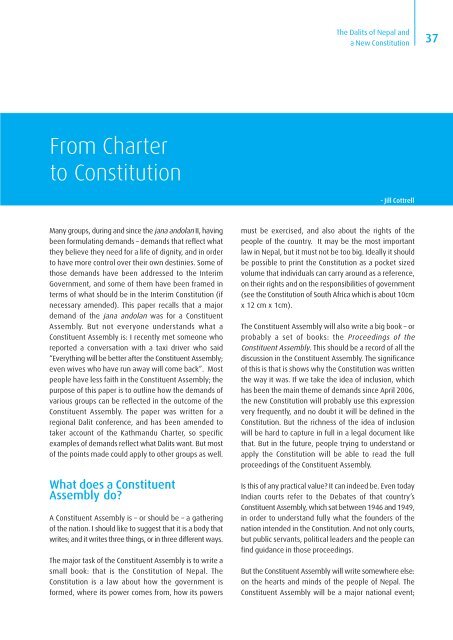The Dalits of Nepal and a New Constitution - ConstitutionNet
The Dalits of Nepal and a New Constitution - ConstitutionNet
The Dalits of Nepal and a New Constitution - ConstitutionNet
Create successful ePaper yourself
Turn your PDF publications into a flip-book with our unique Google optimized e-Paper software.
<strong>The</strong> <strong>Dalits</strong> <strong>of</strong> <strong>Nepal</strong> <strong>and</strong><br />
a <strong>New</strong> <strong>Constitution</strong><br />
37<br />
From Charter<br />
to <strong>Constitution</strong><br />
- Jill Cottrell<br />
Many groups, during <strong>and</strong> since the jana <strong>and</strong>olan II, having<br />
been formulating dem<strong>and</strong>s – dem<strong>and</strong>s that reflect what<br />
they believe they need for a life <strong>of</strong> dignity, <strong>and</strong> in order<br />
to have more control over their own destinies. Some <strong>of</strong><br />
those dem<strong>and</strong>s have been addressed to the Interim<br />
Government, <strong>and</strong> some <strong>of</strong> them have been framed in<br />
terms <strong>of</strong> what should be in the Interim <strong>Constitution</strong> (if<br />
necessary amended). This paper recalls that a major<br />
dem<strong>and</strong> <strong>of</strong> the jana <strong>and</strong>olan was for a Constituent<br />
Assembly. But not everyone underst<strong>and</strong>s what a<br />
Constituent Assembly is: I recently met someone who<br />
reported a conversation with a taxi driver who said<br />
“Everything will be better after the Constituent Assembly;<br />
even wives who have run away will come back”. Most<br />
people have less faith in the Constituent Assembly; the<br />
purpose <strong>of</strong> this paper is to outline how the dem<strong>and</strong>s <strong>of</strong><br />
various groups can be reflected in the outcome <strong>of</strong> the<br />
Constituent Assembly. <strong>The</strong> paper was written for a<br />
regional Dalit conference, <strong>and</strong> has been amended to<br />
taker account <strong>of</strong> the Kathm<strong>and</strong>u Charter, so specific<br />
examples <strong>of</strong> dem<strong>and</strong>s reflect what <strong>Dalits</strong> want. But most<br />
<strong>of</strong> the points made could apply to other groups as well.<br />
What does a Constituent<br />
Assembly do?<br />
A Constituent Assembly is – or should be – a gathering<br />
<strong>of</strong> the nation. I should like to suggest that it is a body that<br />
writes; <strong>and</strong> it writes three things, or in three different ways.<br />
<strong>The</strong> major task <strong>of</strong> the Constituent Assembly is to write a<br />
small book: that is the <strong>Constitution</strong> <strong>of</strong> <strong>Nepal</strong>. <strong>The</strong><br />
<strong>Constitution</strong> is a law about how the government is<br />
formed, where its power comes from, how its powers<br />
must be exercised, <strong>and</strong> also about the rights <strong>of</strong> the<br />
people <strong>of</strong> the country. It may be the most important<br />
law in <strong>Nepal</strong>, but it must not be too big. Ideally it should<br />
be possible to print the <strong>Constitution</strong> as a pocket sized<br />
volume that individuals can carry around as a reference,<br />
on their rights <strong>and</strong> on the responsibilities <strong>of</strong> government<br />
(see the <strong>Constitution</strong> <strong>of</strong> South Africa which is about 10cm<br />
x 12 cm x 1cm).<br />
<strong>The</strong> Constituent Assembly will also write a big book – or<br />
probably a set <strong>of</strong> books: the Proceedings <strong>of</strong> the<br />
Constituent Assembly. This should be a record <strong>of</strong> all the<br />
discussion in the Constituent Assembly. <strong>The</strong> significance<br />
<strong>of</strong> this is that is shows why the <strong>Constitution</strong> was written<br />
the way it was. If we take the idea <strong>of</strong> inclusion, which<br />
has been the main theme <strong>of</strong> dem<strong>and</strong>s since April 2006,<br />
the new <strong>Constitution</strong> will probably use this expression<br />
very frequently, <strong>and</strong> no doubt it will be defined in the<br />
<strong>Constitution</strong>. But the richness <strong>of</strong> the idea <strong>of</strong> inclusion<br />
will be hard to capture in full in a legal document like<br />
that. But in the future, people trying to underst<strong>and</strong> or<br />
apply the <strong>Constitution</strong> will be able to read the full<br />
proceedings <strong>of</strong> the Constituent Assembly.<br />
Is this <strong>of</strong> any practical value? It can indeed be. Even today<br />
Indian courts refer to the Debates <strong>of</strong> that country’s<br />
Constituent Assembly, which sat between 1946 <strong>and</strong> 1949,<br />
in order to underst<strong>and</strong> fully what the founders <strong>of</strong> the<br />
nation intended in the <strong>Constitution</strong>. And not only courts,<br />
but public servants, political leaders <strong>and</strong> the people can<br />
find guidance in those proceedings.<br />
But the Constituent Assembly will write somewhere else:<br />
on the hearts <strong>and</strong> minds <strong>of</strong> the people <strong>of</strong> <strong>Nepal</strong>. <strong>The</strong><br />
Constituent Assembly will be a major national event;








![g]k fnsf blntx? / gofF ;+l jwfg](https://img.yumpu.com/49483602/1/184x260/gk-fnsf-blntx-goff-l-jwfg.jpg?quality=85)



![+ljwfg;ef, /fHosf]k'g](https://img.yumpu.com/41604075/1/184x260/-ljwfgef-fhosfkg.jpg?quality=85)




